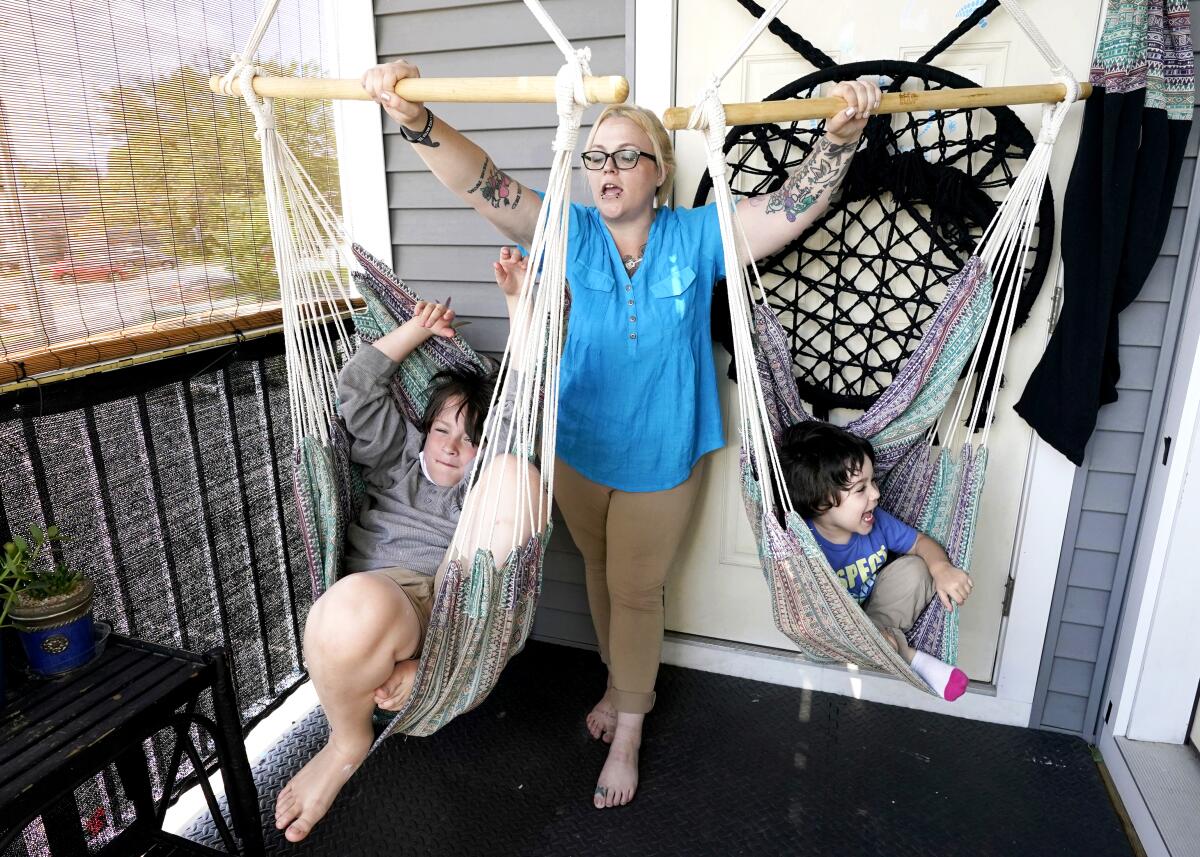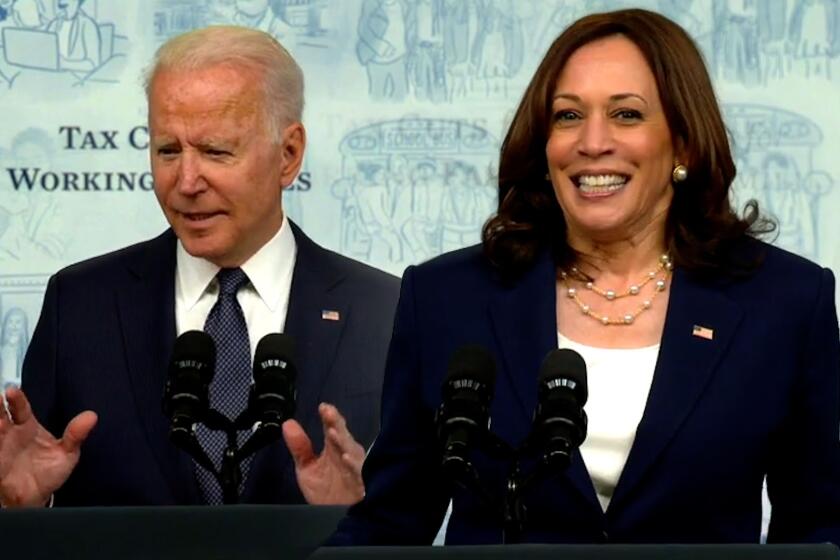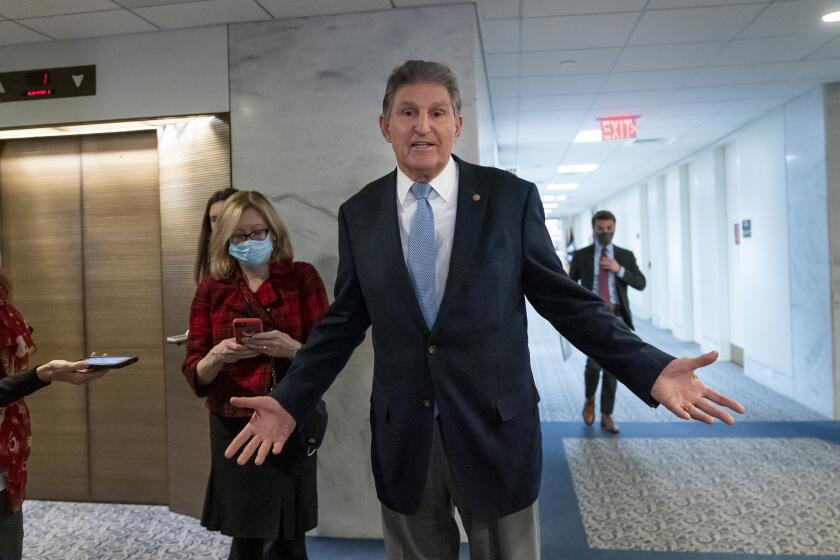You’re not getting child tax credit checks anymore. Here’s why

WASHINGTON — If you raised children during the pandemic, you probably remember something remarkable: getting checks in the mail, every month, from the federal government.
The expanded child tax credit provided a few hundred dollars to help pay for your son’s braces or your daughter’s ballet lessons — or to ease the stress over whether you had enough money to cover the mortgage. Then, one day, the checks just stopped coming.
Jessica Hudson used her $500 monthly payments for her 11-year-old son’s childcare after school while she juggled work and finished a political science degree at San Francisco State. But after the checks stopped, the hours she had devoted to classes were instead spent making stressful calls to coordinate school pick-up or leaving campus early to do it herself.
Hudson’s son lost help with his homework and a support system she didn’t have the capacity to offer as a single, working mother of two who was finishing school.
“It changed how our family functioned,” the 37-year-old recalled. “I remember feeling really resentful when it was ending because what was being communicated to people like me was, ‘Get back to work.’ ”
A sudden end to the payments was not what the measure’s boosters had intended, or its critics had feared. Supporters of the 2021 boost to the Child Tax Credit — part of the $1.9-trillion COVID-19 relief package — had intended it as an initial effort, not a one-off. They hoped that the measure would prove so successful, and so popular, that Congress would feel compelled to extend it.
The policy succeeded at reducing child poverty. The U.S. child poverty rate fell 46% to its lowest level in 2021, according to the U.S. Census Bureau. The temporary credit lifted nearly 4 million children out of poverty and reduced the number of households that reported not having enough food.
The expanded benefit delivered more money to 61 million children in 36 million households and reached even the poorest families, who didn’t qualify before because they had no income. The monthly payments allowed families to afford essentials, including groceries, rent and clothing, researchers found.
But as the pandemic receded, so did the expanded credit’s chances of survival. In January 2022, Republicans and Democratic Sen. Joe Manchin refused to extend it. The effects of the program’s end were immediate, driving 3.7 million more children back into poverty that month compared with the month before.
A year later, efforts to revive the $100-billion program have failed again, erasing one of President Biden’s biggest domestic achievements and prompting the program’s supporters to reflect on why a policy that changed so many people’s lives just fizzled out.
Rep. Rosa DeLauro (D-Conn.) was always concerned the temporary nature of the credit would undercut its effects, she told The Times.
“It didn’t have enough time to just root in the way you need it to,” said DeLauro, who advocated for an expanded child tax credit for two decades and pushed for its inclusion in the COVID-19 relief package. “You need permanence at the outset.”
The first payments from the expanded federal child tax credit are being deposited in families’ bank accounts this week. Here’s what to expect.
The policy’s demise has confounded policy experts, who point to ample evidence that the increased benefit helped close gaps in the existing child tax credit.
“It was a policy that was intended in its design to help kids — and it did,” said Megan A Curran, director of policy at the Center on Poverty and Social Policy at Columbia University.
Critics argued the revamped policy was too costly and guaranteed monthly payments would discourage parents from finding work. But research showed the 2021 payments did not deter parents from working.
Though the Child Tax Credit has existed since 1997, 2021 was the first year families who pay no federal income tax were able to receive the benefit. The change increased the maximum benefit from $2,000 to $3,000 for parents of children age 6 to 17 and $3,600 for parents of children under 6. The first half of the credit came in six monthly payments, with the second half delivered as a lump sum that families could claim in their tax returns — a policy structure that immediately reduced poverty, researchers say.
The credit was most beneficial to groups historically left out of the program: Black and Latino communities, single-parent households, large families, households in rural areas and those with young children, according to researchers at Columbia University. Research showed 91% of low-income families used the money to afford basic household needs, according to the Center for Budget and Policy Priorities. But it also provided a much needed lifeline to middle-class families that advocates hoped would lead to its preservation.
“One person told me, ‘I’m OK today, but I’m one car accident away from disaster,’ ” said Adam Ruben, director of the advocacy group Economic Security Project Action. “That’s what it means to live without a safety net. It gives people a little bit of breathing room and cushion when something goes wrong.”
The program received strong support among recipients of the money but failed to gain the sort of widespread backing that Democrats had hoped would ensure its survival.
“It’s baffling to me that it wasn’t more popular,” said Natasha Pilkauskas, a poverty researcher and associate professor of public policy at the University of Michigan.
The enhanced payment may have been lost in the wash of stimulus money Americans received at the height of the pandemic, Pilkauskas said. Some recipients may have thought that the money was part of the broader, temporary stimulus efforts, rather than a child-specific benefit that they could factor into their budget.
The expiration of the Child Tax Credit means 3.7 million more children in poverty. Is this the America we want?
Manchin and Republicans cited concerns about the program’s price tag increasing inflation, but a group of more than 200 economists wrote an open letter last month urging lawmakers to reinstate the expanded credit, arguing at under 0.4% of the GDP, it is “simply too small to meaningfully increase inflation” and would aid families in grappling with rising costs.
A group of Republican senators proposed their own version of the expanded benefit, but the plan excluded the nation’s poorest families and offset costs by cutting funding for other programs low-income families rely on — a nonstarter for Democrats. In December, lawmakers failed to reach a deal to tie it to expiring corporate tax cuts as part of a $1.7-trillion spending bill in a last-ditch effort to renew it before Republicans take control of the House of Representatives this month.
Critics’ prevailing concern about the benefit is that it lacks a requirement that recipients work, a condition that supporters say prevents money from reaching the poorest families and one that skeptics argue would lead to a reduction in the labor force.
Incentivizing employment is the strongest path out of poverty, said Robert Doar, president of the American Enterprise Institute, a conservative think tank. The monthly federal payments failed to help families address some of the underlying issues that keep them in poverty, he said.
Doar, who spent two decades running social service programs for New York state and New York City, said the policy should be discussed alongside other antipoverty programs, including the earned income tax credit for low- and moderate-income working people, housing aid, the Supplemental Nutrition Assistance Program and public health insurance.
“There’s a whole basket full of various efforts that as it plays out at the local level ... they get the benefit of these things combined,” he said. “You can’t talk about the child tax credit in isolation.”
Despite the partisan debate, advocates and opponents stress a child tax credit is still on the books. The program doubled in value under the Trump administration as part of the GOP tax law in 2017, a suite of tax provisions due to lapse at the end of 2025.
But under the existing CTC, about 19 million children aren’t receiving the full payment because their parents earn too little or no income. More than 50% of poor children in six California congressional districts receive only part of the $2,000 credit or no credit at all because their family income is not high enough to qualify, according to a 2019 Columbia University report.
In California’s 16th district, 59% of children did not reap the full benefit, and in the 40th district, 57% were unable to access all of it.
With the 2025 expiration of the Trump-era boost to the benefit on the horizon and some bipartisan support for a deal, some experts see room for more negotiations.
“Both parties agree the poverty effects are real — it’s in the data,” said Rachel Snyderman, senior associate director at the Bipartisan Policy Center.
Republicans will continue to focus on the price tag of further expanding the program and its effect on labor market participation. But a compromise could include providing part of the credit to all households with children and having another part phase in as income increases, Snyderman said.
“This is not the end of the line for expanded child tax credit,” Curran said. “It’s made the case for itself to be continued — whether that happens in a month or a year or however long it takes.”
Though the pandemic-era expanded credit has already expired, families may not realize they’re losing out on the increased benefit until this year’s tax bill arrives. Lindsay Rojas, a coordinator for United Way Bay Area’s free tax help program, an antipoverty group, said she’s been preparing her team on how to be more empathetic with families in helping them understand the changes to the child tax credit.
“There’s been a lot of layoffs so it’s probably going to be a startling realization for a lot of people once tax season kicks off,” she said.
Despite an impasse on Capitol Hill, a dozen states and cities have implemented their own version of a child tax credit. In 2019, California became the first state to establish a young child tax credit, a $1,000-a-year credit for low-income families with children under age 6. Families earning below $25,000 received the credit but needed to show earnings as little as $1 to receive it. In July 2022, the state removed its earning requirement. New Jersey and Vermont have followed suit in establishing permanent child tax credits while states like New Mexico have enacted short-term policies.
States could go further on their own. If California replaced the young child tax credit with a broader $1,700 child tax credit for children 18 and under, it could achieve a 25% reduction in child poverty, according to the Institute on Taxation and Economic Policy, a tax policy think tank based in Washington, D.C.
More to Read
Get the L.A. Times Politics newsletter
Deeply reported insights into legislation, politics and policy from Sacramento, Washington and beyond. In your inbox three times per week.
You may occasionally receive promotional content from the Los Angeles Times.













